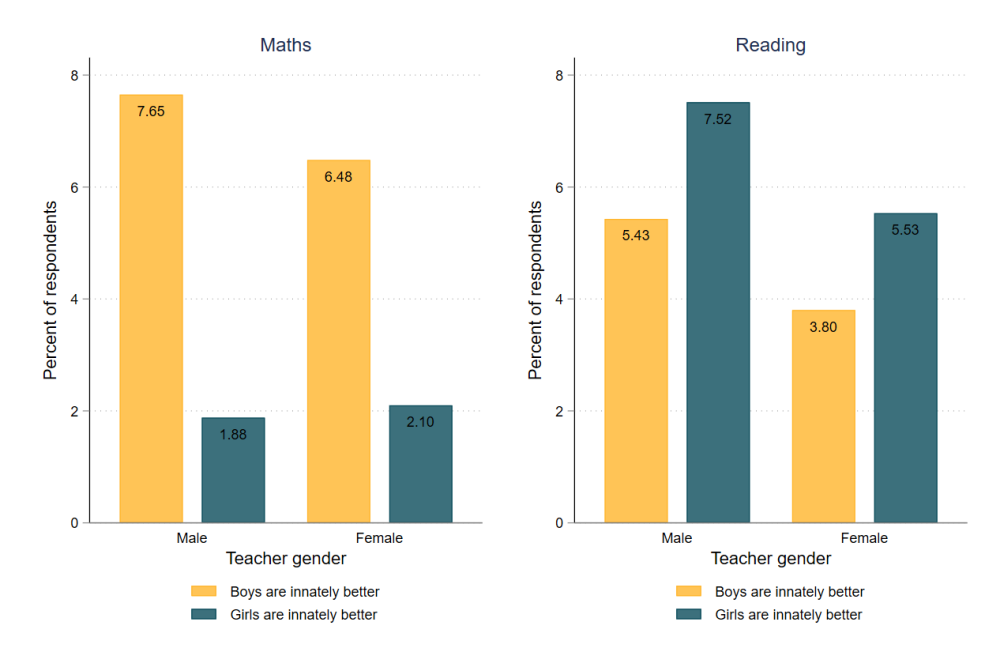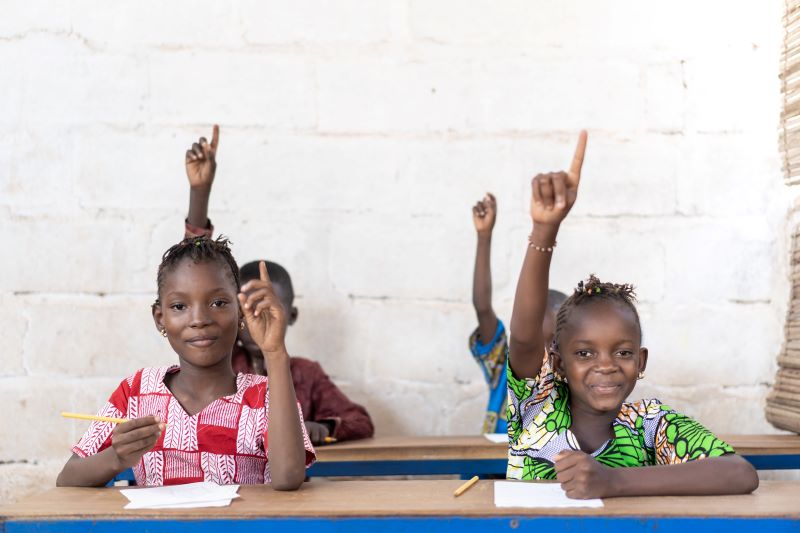Recommended
Teachers often hold beliefs that mirror societal norms. These can adversely affect children’s academic performance and wellbeing in school, curtail career aspirations, and even shape norms in society once children leave school. Values instilled in school could go some way to explaining inequality that remains in society, even where education access and test scores are equalising.
In this series, we bring together existing evidence on how different biases held by teachers around gender, race, ethnicity, socio-economic class, and especially their intersection, affect students. Teacher bias is a widespread and recognised phenomenon but is studied sparingly and in silos, limiting the potential for progressive reform at scale in teacher training, curriculum or system administration.
In this blog we explore the mechanisms by which teacher beliefs on gender affect students, and discuss possible remedial interventions.
Figure 1: Mapping teacher beliefs to student and teacher outcomes

Teacher beliefs are an under-explored but important component of teacher quality
Available evidence from rich and developing countries alike conveys a single message—if teachers have regressive gender norms, this affects students. Teachers’ biases are transmitted through their interactions with students and can affect how they teach thus significantly affecting students’ experiences in school. While the effects are mainly cognitive, evidence also points to the significance of teacher role models in shaping students' beliefs. There are direct impacts on students' long and short term educational choices as well as their consequent earnings.
Teacher beliefs about gender directly impact students’ academic achievement and choices
Gender biases are pervasive in society, especially in developing countries, and as a result girls have fewer learning opportunities and employment options. Teacher-held gender stereotypes can affect girls’ academic achievement in schools in regular assessments, as well as their choices for academic progression in later years. Teachers with more traditional gender views have been shown to cause poorer performance by girls in standardised tests compared to their peers, with the effect compounded with continued exposure to the same teacher. Students are more likely to be disengaged especially in STEM courses when teachers project traditional gender stereotypes, with a larger negative effect from female than male teachers.
Teachers demonstrate and transmit these traditional biases in their estimations of students’ abilities or tendencies
Studies have shown that admissions to these higher education courses can be hindered for girls due to them being perceived as less competent than their male counterparts. Data from large-scale assessments, such as the PASEC (see Figure 2), confirm this—both male and female teachers rate boys as being innately better than girls at maths. Conversely, girls are favoured at being better at reading than boys by teachers of both genders. Girls are similarly impacted by these biases in later years of schooling, often negatively graded in peer-tutoring in STEM courses, even by female tutors, despite being equally engaged and participatory.
Figure 2: Teachers’ opinions of boys’ and girls’ relative innate abilities in maths and reading, by teacher gender


Source: Authors’ construction based on data from PASEC (2014)
The “disruptive boy” bias is a gender-based bias
Teachers are more likely to describe boys' behaviours as disruptive or rule-breaking, and this leads to higher suspensions and grade retention, especially among ethnic or racial minorities. Biases held by teachers have been found to affect grading tendencies in assessments on observable differences like gender and race. Data from the UK’s teacher assessments—used in lieu of higher secondary grade exams during Covid—reveals that boys were graded less favourably than girls in most subjects. Even years later, effects of this favouritism can last; a study in France found that middle school teachers favoured girls to boys when it came to grading, causing a fifth of the boys in the school to fall behind academically compared to their peers in the long term.
These beliefs can have a long term impact on children
Implicit and explicit biases can perpetuate norms that hold some students back from achieving their full potential academically and in terms of lifetime earnings. Gendered beliefs held by primary school teachers about students’ comparative abilities can affect their academic achievements at middle and high school, as well as their enrollment and achievement in higher education courses and admission exams, and their occupational choice and earnings.
Like teacher like student: what teachers believe about students, students believe about themselves
Even if teachers may not profess and promote gender biases, their perception of students’ relative ability can influence students’ perception of themselves. Students’ motivation, attitudes, and perceptions of self efficacy have been found to significantly impact their pursuit of STEM careers and courses, more so than even their families’ socio-economic backgrounds. Teachers’ stereotypes can result in girls having lower self confidence and self efficacy compared to their male peers. Students who are surrounded by parents, teachers, and peers who promote interest and engagement in science and maths report greater self efficacy and perceptions of their beliefs in the fields.
The importance of positive role models is also clear. Female teachers can actually have larger negative effects than their male colleagues if they perpetuate gender stereotypes. On the other hand, seeing positive examples that challenge traditionally held beliefs regarding gendered ability can help reverse students’ own beliefs and consequent outcomes.
Low-cost interventions have worked to alter these beliefs for both teachers and students, but long-term change requires more investment
There are a few mechanisms through which teachers’ beliefs about gender may be shaped. Positive messaging campaigns have been found to yield some improvements in attitudes towards gender (as demonstrated through information-seeking and sharing follow-up behaviours), although there is little evidence about the persistence of these improvements over time. And it’s likely that social media interventions need to be complemented by action at the school and community level if such changes in beliefs are to translate to longer term changes in teacher practice.
Another way to address pervasive biases is through textbooks. While the volume of evidence is small, it suggests that depicting gender norms positively in textbooks is just as crucial as targeting teachers directly. When accompanied by additions to the curriculum, effects of exposure to progressive information have translated to shifts in behaviours and attitudes towards gender among both students and teachers when measured a year later, alongside improvements in learning outcomes.
There is also a range of low-cost classroom based interventions—like classroom discussions, and incorporating non gender biased language in school communications—that have been found to change both behaviour and perceptions among adolescent students, with persistent impacts in the medium term, even for students who have spent years in an educational system that reinforces existing biases. Exposing kids to progressive gender integration in society has proved to have large positive effects on both boys and girls’ attitudes towards gender equality.
As girls and boys education outcomes increasingly converge, it becomes even more imperative that we turn our attention to the role that education can play in equalising life outcomes. Schools are part of communities, and where sexist beliefs exist in communities they probably exist among teachers too. Being aware of where those biases exist is a first step. And then we need to test, evaluate and document a range of interventions that address gender bias and help equalise life outcomes for boys and girls after school.
Disclaimer
CGD blog posts reflect the views of the authors, drawing on prior research and experience in their areas of expertise. CGD is a nonpartisan, independent organization and does not take institutional positions.






